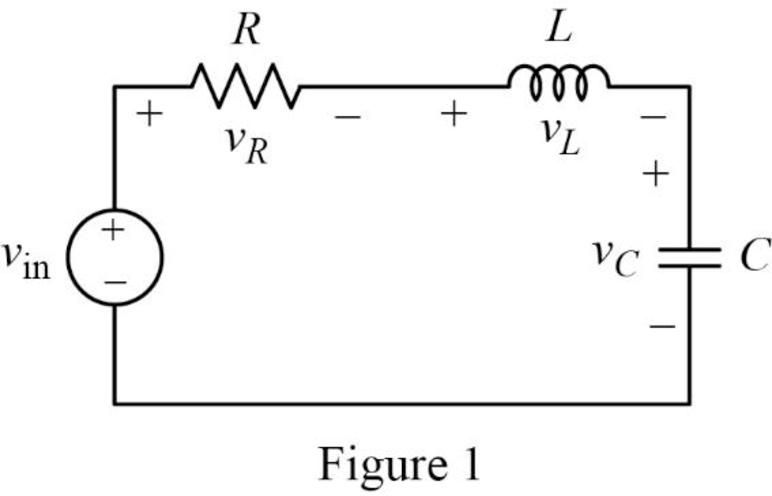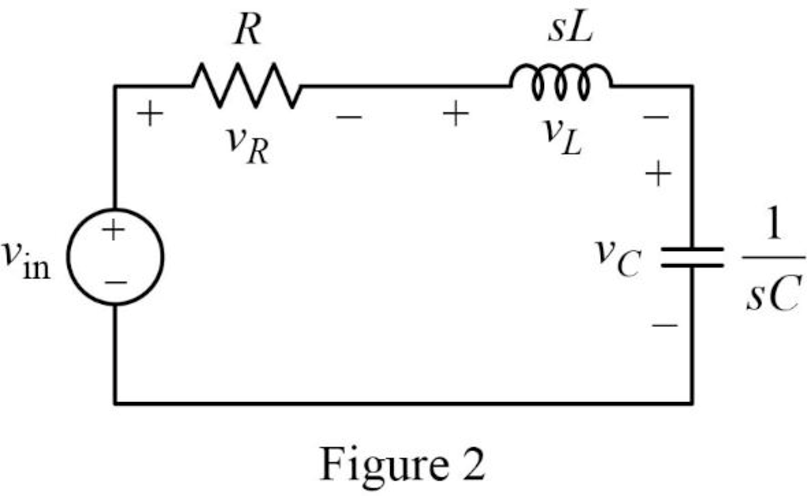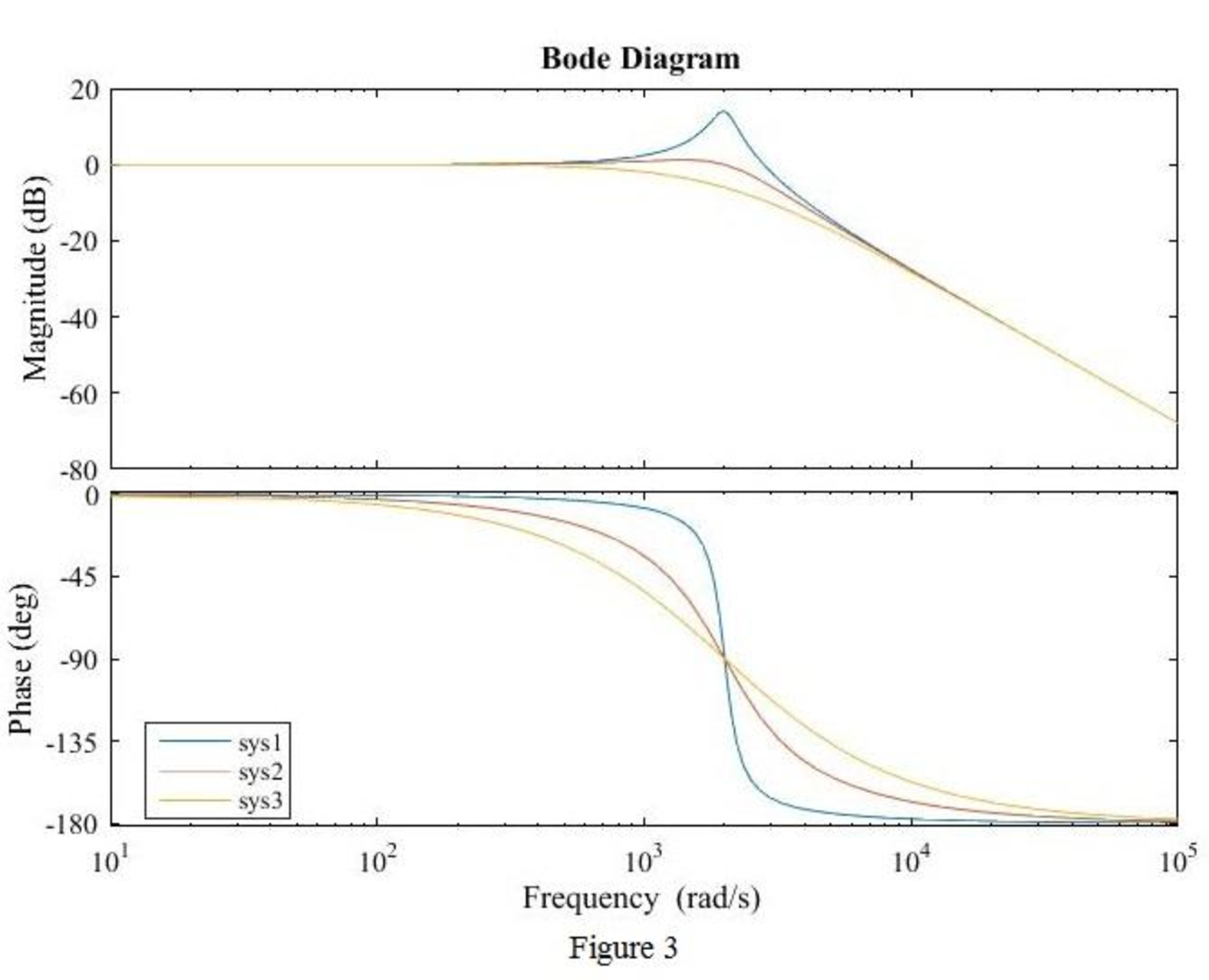
(a)
Find the value of
(a)
Answer to Problem 15E
The value of
Explanation of Solution
Given data:
Refer to Figure 15.53 in the textbook.
The transfer function of the circuit in Figure 15.53 is,
Formula used:
Write the expression to calculate the impedance of the passive elements resistor, inductor and capacitor in s-domain.
Here,
Calculation:
Given series RLC circuit is drawn as Figure 1.

The Figure 1 is redrawn as impedance circuit in s-domain in Figure 2 using the equations (2), (3) and (4).

Write the general expression to calculate the transfer function of the circuit in Figure 2.
Here,
Apply Kirchhoff’s voltage law on Figure 2 to find
Rearrange the above equation to find
Substitute
Compare the above equation with the equation (1) to obtain the following values.
Rearrange the equation (6).
Rearrange the above equation to find
Rearrange the equation (7) to find
Substitute
Conclusion:
Thus, the value of
(b)
Find the values of inductor
(b)
Answer to Problem 15E
The value of inductor
Explanation of Solution
Given data:
The value of the resistor
The value of the resonant frequency
Calculation:
Case (i):
From part (a),
Substitute
Rearrange the above equation to find
Rearrange the above equation to find
Rearrange the equation (9).
Rearrange the above equation to find
Substitute
Rearrange the above equation to find
Take square root on both sides of the above equation to find
Substitute
Case (ii):
Substitute
Rearrange the above equation to find
Rearrange the above equation to find
Substitute
Rearrange the above equation to find
Take square root on both sides of the above equation to find
Substitute
Case (iii):
Substitute
Rearrange the above equation to find
Rearrange the above equation to find
Substitute
Rearrange the above equation to find
Take square root on both sides of the above equation to find
Substitute
Conclusion:
Thus, the value of inductor
(c)
Construct the magnitude Bode plots for the three cases
(c)
Explanation of Solution
Calculation:
Simplify the equation (1) to find
Case (i):
Substitute
Case (ii):
Substitute
Case (iii):
Substitute
The equations (15), (16) and (17) are the transfer function of the given series RLC circuit at three different cases
The MATLAB code is given below to sketch the magnitude Bode plots for the three cases using the equations (15), (16) and (17).
MATLAB Code:
clc;
clear all;
close all;
sys1=tf([(4*10^6)],[1 400 (4*10^6)]);
sys2=tf([(4*10^6)],[1 2000 (4*10^6)]);
sys3=tf([(4*10^6)],[1 4000 (4*10^6)]);
bode(sys1,sys2,sys3)
legend({'sys1','sys2','sys3'},'Location','best')
Output:
The MATLAB output Bode plot of the three transfer functions is shown Figure 1.

Conclusion:
Thus, the magnitude Bode plot for the three cases
Want to see more full solutions like this?
Chapter 15 Solutions
Loose Leaf for Engineering Circuit Analysis Format: Loose-leaf
- Reversing 1⏀ Motors-all the wires are not used. Use the data sheet b on page 383 to draw the wiring diagram. Note: interchange the red and black leads to reverse the motor rotation. Use only the number of contacts required. Insulate any motor wire not used with a wire nut. Wire the motor to operate in forward and reverse at 115 VACarrow_forwardSee both images to answerarrow_forwardSee both images to answerarrow_forward
- An inner-city electric bus with 7,200kg weight and average speed of 72 km/hour operates using a hybrid power source of lithium-ion battery pack and a bank of super capacitor. equipped with a lithium battery pack and a bank of supercapacitor. The energy content of the supercapacitor bank is twice the regenerative breaking energy of the electric bus at average speed. The electric bus commutes 490 km per charged battery and consumes 400 Wh/km. Design the supercapacitor bank to provide 100V output, based on supercapacitor cells with 3600F capacitance and 2V. Calculate the energy density of the supercapacitor at the cell level, assume cells with 10cm diameter and 15 cm height. 3. Design the battery pack for the electric bus by assuming that the energy of regenerative breaking will not be used for commuting but used to run the vehicle’s accessories. The unit cell of the battery pack is a lithium-ion…arrow_forwardA rod coincident with the z-axis extends from 0 to -L. If the rod carries a uniform charge density of pL (a) calculate the electric field intensity at a point h on the z-axis. (b) Use your answer to show that when h>>L the rod behaves as a point charge of value plL . (c) How much larger than the length of the rod must h be in order that the answer to part b) is a reasonably accurate estimate.arrow_forwardThe separation of two point charges with charges Q1=36pC and ,Q2=9pC respectively, is 3 cm. If a third point charge Q3 is placed on the line joining Q1 and Q2 at a distance d from Q1 find Q3 and d that ensures that the force on all charges is zero.arrow_forward
- 5. The electric field on the positive z-axis due to a uniformly charged disk of radius a that lies in the x-y plane with center at the origin is claimed to be given by - Ps Z 2E 2 a² + z² Where ps is the surface charge density on the disk. Without deriving this formula, evaluate it for its probable correctness. (a) Is its symmetry correct? Explain. (b) If z>> a, it reduces to that of a point charge of value a²ps (c) if z> z is large the formula reduces to that of an infinite plane.arrow_forwardA rod coincident with the z-axis extends from 0 to L. If the rod carries a uniform charge density of pL , calculate the electric field intensity at a point h on the y-axis.arrow_forwardLet the x-axis carry a line charge of 2 nC/m and a plane Z=3 carry a surface charge of 5 nC/m^2. If a point charge of 100pC is located at (4,1,-3), find E at (1, 1,1).arrow_forward
- Consider the circuit in Fig. 4. (a) Use mesh analysis to find the currents i1, i2, i3. Hint use the supermode method. (10 marks) (b) Determine the Thévenin equivalent of the circuit that is connected to the dependent source (10 marks). (c) If the dependent source was replaced with a load resistor, what would be the value of its resistance so that the load would receive the maximum power from the rest of the circuit? (2 mark)arrow_forwardFormal Charge Distribution vs Oxidation States Te- For the Lewis diagram, above, determine: 0 The overall charge of the molecular species shown. -2 The formal charge on the tellurium atom. +7 The formal oxidation number of the tellurium atom. 1 pts Submit Answer Incorrect. Tries 3/5 Previous Tries Review: • For overall charge, compare the number of electrons depicted with the sum of the valence electrons for the free atoms. (Remember that an electron has a negative charge.) • Rules Governing Formal Charge • Rules for Assigning Oxidation States.arrow_forward. (a) Use mesh analysis to find the current i. (b) Determine the Norton equivalent of the circuit that is connected to the 5 ohm resistor (c) If the 5 ohm resistor was replaced with a load resistor, what would be the value of its resistance so that the load would receive the maximum power from the rest of the circuit?arrow_forward
 Introductory Circuit Analysis (13th Edition)Electrical EngineeringISBN:9780133923605Author:Robert L. BoylestadPublisher:PEARSON
Introductory Circuit Analysis (13th Edition)Electrical EngineeringISBN:9780133923605Author:Robert L. BoylestadPublisher:PEARSON Delmar's Standard Textbook Of ElectricityElectrical EngineeringISBN:9781337900348Author:Stephen L. HermanPublisher:Cengage Learning
Delmar's Standard Textbook Of ElectricityElectrical EngineeringISBN:9781337900348Author:Stephen L. HermanPublisher:Cengage Learning Programmable Logic ControllersElectrical EngineeringISBN:9780073373843Author:Frank D. PetruzellaPublisher:McGraw-Hill Education
Programmable Logic ControllersElectrical EngineeringISBN:9780073373843Author:Frank D. PetruzellaPublisher:McGraw-Hill Education Fundamentals of Electric CircuitsElectrical EngineeringISBN:9780078028229Author:Charles K Alexander, Matthew SadikuPublisher:McGraw-Hill Education
Fundamentals of Electric CircuitsElectrical EngineeringISBN:9780078028229Author:Charles K Alexander, Matthew SadikuPublisher:McGraw-Hill Education Electric Circuits. (11th Edition)Electrical EngineeringISBN:9780134746968Author:James W. Nilsson, Susan RiedelPublisher:PEARSON
Electric Circuits. (11th Edition)Electrical EngineeringISBN:9780134746968Author:James W. Nilsson, Susan RiedelPublisher:PEARSON Engineering ElectromagneticsElectrical EngineeringISBN:9780078028151Author:Hayt, William H. (william Hart), Jr, BUCK, John A.Publisher:Mcgraw-hill Education,
Engineering ElectromagneticsElectrical EngineeringISBN:9780078028151Author:Hayt, William H. (william Hart), Jr, BUCK, John A.Publisher:Mcgraw-hill Education,





